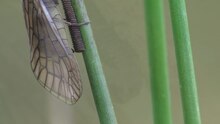Common mud fly
| Common mud fly | ||||||||||||
|---|---|---|---|---|---|---|---|---|---|---|---|---|

Common mud fly ( Sialis lutaria ) |
||||||||||||
| Systematics | ||||||||||||
|
||||||||||||
| Scientific name | ||||||||||||
| Sialis lutaria | ||||||||||||
| ( Linnaeus , 1758) |
The common mud fly ( Sialis lutaria ), also known as the common water butterfly fly , is a species of mud fly and is widespread in Europe . Here it is the most common and widespread species of the genus .
features
The body length is about 10-20 mm, up to a maximum of 25 mm, with the females becoming slightly larger. The wingspan is about 22-35 mm. The basic color of the body is dark brown to blackish brown. The wings, which are held in the shape of a roof when at rest, protrude far beyond the abdomen. They are gray-brown and have a dense, dark network of veins. The veins are not forked at the edge. The antennae are long and thread-shaped. There are a number of similar types of Sialis that can be distinguished by their genitals.
The larvae reach lengths of around 17 mm. They have large heads with powerful mouthparts and three pairs of legs. On the abdomen are feather-like gills on the sides.
distribution and habitat
The species inhabits large parts of Europe, but is absent in many areas of southern and eastern Europe. Evidence can be found mainly from France , Great Britain , Ireland , Belgium , the Netherlands , Luxembourg , Germany , Switzerland , Denmark , Sweden and Norway (far beyond the Arctic Circle), Poland , the Czech Republic , Austria , Hungary , Slovenia and Croatia . But the species is also known from northern Spain and Italy , Finland , Estonia , Lithuania , Belarus , the far west of Russia , Serbia , Bulgaria and Albania . In addition, the species may be even more widespread in Europe.
The species is found on the banks of calmly flowing brooks or rivers, ponds, ponds and nutrient-rich lakes and always near water. The larvae live in waters that are preferably rich in plants.
Way of life
In spring, mating takes place on the ground. The males follow the females on foot, who stop when they are ready to mate. The male holds the female with his front legs, pushes his head under the body of the female and pushes his abdomen diagonally upwards until it has reached the semen container of the female and can then push the semen packet into it. The wall of the semen package ( spermatophore ) dissolves and the semen migrate into the female sexual opening. After mating, the female lays its approximately 200 eggs in clumps, mostly on a plant stem in the reed bed above the water. The newly hatched larvae are washed into the water by rain or they fall into it. Sometimes the eggs are laid on water plants or stones. The larvae then have to reach the water as quickly as possible after hatching. They predatory feed on small aquatic creatures. Young larvae hunt among aquatic plants, older ones withdraw into the mud. They rise up to pupate and leave the water. From this moment on, tracheal breathing begins. Pupation takes place in the ground on the bank. From the pupae eventually slip imagines that live only a few days and do not take food. You can find them from April to August, especially often in May and June. They sometimes fly around aquatic plants in the sunshine, but climb much more often in the bank plants because they don't like to fly. They stay close to their larval waters. The total development of the species takes about 2 years, sometimes just a year.
Taxonomy
The basionym of the species is Hemerobius lutarius . There are also other synonyms in the literature , such as Semblis lutaria ( Linnaeus 1758), Hemerobius aquaticus Retzius 1783, Sialis excelsior Navás 1916 and Sialis nigra Latreille 1805.
Literature and Sources
- Michael Chinery: Parey's Book of Insects . Franckh-Kosmos Verlags-GmbH & Co., Stuttgart 2004, ISBN 3-440-09969-5 , p. 108.
- Dr. Helgard Reichholf-Riehm, Ruth Kühbandner: Insects with appendix arachnids (Steinbach's natural guide) New, edited special edition. Mosaik Verlag, Munich 1984, ISBN 978-3-576-10562-1 , p. 96.
- Karel Šťastný: On rivers and lakes German first edition. C. Bertelsmann Jugendbuch Verlag, Munich 2003, ISBN 3-570-21240-8 , p. 68.
- Jiří Zahradník: The Cosmos Insect Guide 6th edition. Franckh-Kosmos Verlags-GmbH & Co., Stuttgart 2002, ISBN 3-440-09388-3 , p. 132.


